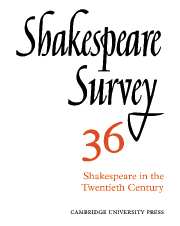Book contents
- Frontmatter
- Shakespeare and the Living Dramatist
- Blood and Wine: Tragic Ritual from Aeschylus to Soyinka
- Hamlet Andante/Hamlet Allegro: Tom Stoppard’s Two Versions
- Auden, Shakespeare, and the Defence of Poetry
- Graves on Lovers, and Shakespeare at a Lovers’ Funeral
- Tragic Balance in Hamlet
- Hamlet Across Space and Time
- Shakespeare’s Scripts and the Modern Director
- ‘He Shall Live a Man Forbid’: Ingmar Bergman’s Macbeth
- Komisarjevsky at Stratford-upon-Avon
- Troilus and Cressida and the Definition of Beauty
- The Pastoral Reckoning in Cymbeline
- New Created Creatures: Ralph Crane and the Stage Directions in The Tempest
- Arden of Faversham
- ‘Pickleherring’ and English Actors in Germany
- Shakespeare Performances in Stratford-upon-Avon and London, 1981–2
- The Year's Contributions to Shakespearian Study 1 Critical Studies
- 2 Shakespeare’s Life, Times and Stage
- 3 Textual Studies
- Index
- Plate Section
Hamlet Andante/Hamlet Allegro: Tom Stoppard’s Two Versions
Published online by Cambridge University Press: 28 March 2007
- Frontmatter
- Shakespeare and the Living Dramatist
- Blood and Wine: Tragic Ritual from Aeschylus to Soyinka
- Hamlet Andante/Hamlet Allegro: Tom Stoppard’s Two Versions
- Auden, Shakespeare, and the Defence of Poetry
- Graves on Lovers, and Shakespeare at a Lovers’ Funeral
- Tragic Balance in Hamlet
- Hamlet Across Space and Time
- Shakespeare’s Scripts and the Modern Director
- ‘He Shall Live a Man Forbid’: Ingmar Bergman’s Macbeth
- Komisarjevsky at Stratford-upon-Avon
- Troilus and Cressida and the Definition of Beauty
- The Pastoral Reckoning in Cymbeline
- New Created Creatures: Ralph Crane and the Stage Directions in The Tempest
- Arden of Faversham
- ‘Pickleherring’ and English Actors in Germany
- Shakespeare Performances in Stratford-upon-Avon and London, 1981–2
- The Year's Contributions to Shakespearian Study 1 Critical Studies
- 2 Shakespeare’s Life, Times and Stage
- 3 Textual Studies
- Index
- Plate Section
Summary
With the passage of time, Tom Stoppard’s first Hamlet begins to look like his Romeo and Juliet: an experiment undertaken during a period of energetic theatrical activity in England, and a spirited union of materials from various dramatic and non-dramatic sources. As soon as Rosencrantz and Guildenstern are Dead appeared in performance, reviewers and academic commentators recognized its derivation not only from Shakespeare’s Hamlet, but also from Beckett’s Waiting for Godot. They have noticed other influences as well: Pirandello, T. S. Eliot, Wilde, Kafka, and Pinter have left theatrical or literary traces, and Ludwig Wittgenstein’s late Investigations provide philosophical bearings. For the most part, critics describe the composition of Stoppard’s play as if it had been neatly prescribed by a recipe: plot and characters from Shakespeare folded into a Beckettian ambiance, or vice versa; a dash of concept, echo or tone from the other dramatic or literary sources; and Wittgenstein’s philosophy cracked, its language-games separated and used to bind the other ingredients. Yet the texture of Rosencrantz and Guildenstern are Dead hardly resembles that of a pudding, or any other confection assembled in a predictable way. Let that be the character note of Stoppard’s dramaturgy.
- Type
- Chapter
- Information
- Shakespeare Survey , pp. 21 - 28Publisher: Cambridge University PressPrint publication year: 1983



